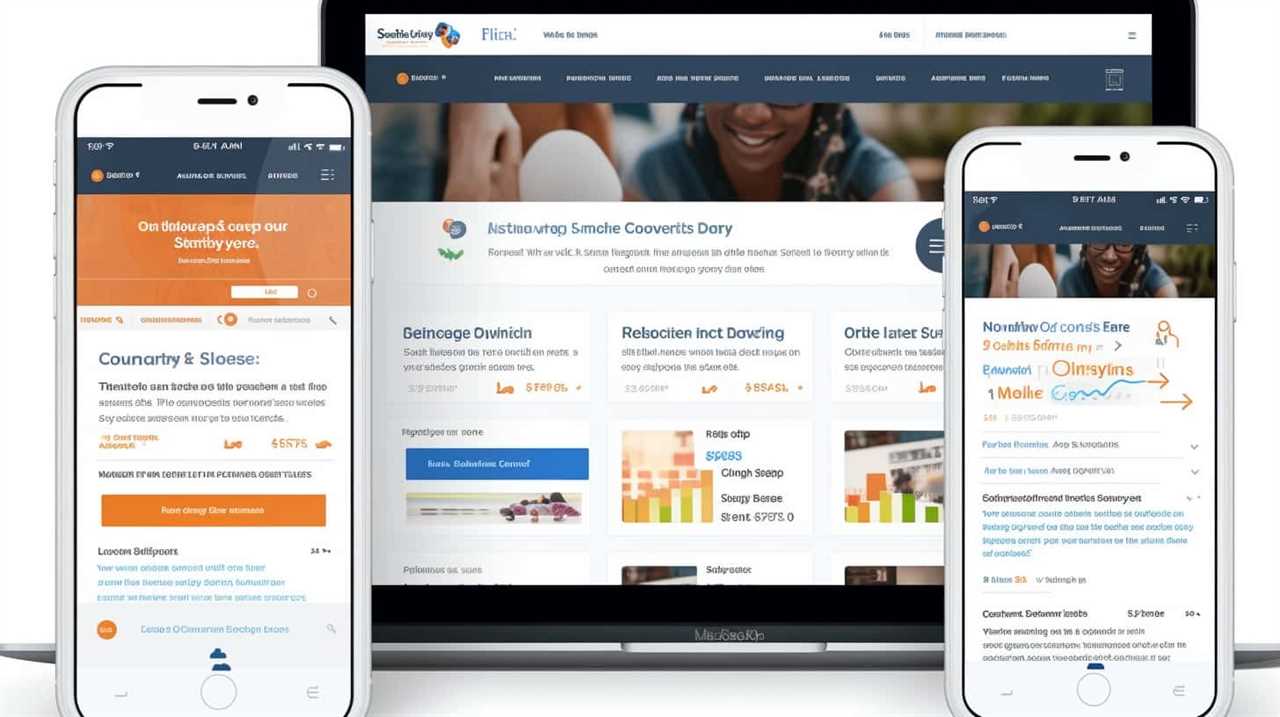Are you struggling to attract patients to your small medical practice? We understand the challenges involved.
That’s why we’re here to help you boost your online patient engagement through effective SEO strategies. By optimizing your website content with relevant keywords, leveraging local SEO, and building a strong online reputation, you can increase your visibility and attract more patients.
Let us guide you on this journey to online success and help you take your clinic to the next level.
Key Takeaways
- SEO increases online visibility for small healthcare clinics.
- Understanding patient search behavior and optimizing website content improves search engine rankings.
- Well-designed websites attract and engage visitors, improving search rankings.
- Local SEO enhances online visibility and attracts potential patients.
Why SEO Is Vital for Small Healthcare Clinics
SEO is essential for small healthcare clinics to increase their online visibility and attract more patients. In today’s digital age, patients are increasingly turning to the internet to search for healthcare providers and information about their conditions. Therefore, it’s crucial for clinics to have a strong online presence in order to reach these potential patients effectively.

Understanding patient needs is a fundamental aspect of developing effective SEO strategies. By conducting thorough research and analysis, clinics can gain insights into the keywords and phrases patients are using to search for healthcare services. This knowledge allows clinics to optimize their website content and ensure that it aligns with what patients are looking for.
Implementing effective SEO strategies not only improves a clinic’s search engine ranking but also enhances the overall user experience on their website. By employing techniques such as optimizing page load speed, creating relevant and informative content, and incorporating user-friendly navigation, clinics can provide a seamless online experience for patients.
Moreover, by investing in SEO, small healthcare clinics can level the playing field with larger competitors. With limited marketing budgets, SEO provides an affordable and efficient way for clinics to compete and attract patients in their local area.
Understanding the Search Behavior of Patients
To better understand the search behavior of patients, we analyze the keywords and phrases they use to find healthcare services online. By examining patient search trends, we can gain insights into their preferences and optimize our online presence accordingly.

One effective way to improve our visibility in search results is by optimizing meta tags. Meta tags are snippets of HTML code that provide information about a web page to search engines. They play a crucial role in attracting potential patients to our website. By strategically incorporating keywords and phrases that patients commonly search for, we increase the likelihood of our website appearing in relevant search results.
To identify the most relevant keywords and phrases, we can utilize keyword research tools and analyze our competitors’ websites. By understanding the language patients use when searching for healthcare services, we can tailor our content to match their needs and expectations. This approach not only improves our search engine rankings but also enhances the overall user experience on our website.
Optimizing Website Content for Relevant Keywords
When it comes to optimizing website content for relevant keywords, there are a few key points to consider.
First, targeting specific keywords that are relevant to your healthcare clinic’s services is crucial in attracting the right audience. By incorporating these keywords strategically throughout your website content, you can improve your search rankings and increase visibility.

This, in turn, will help potential patients find your clinic more easily and engage with your online presence.
Targeting Specific Keywords
We can enhance online patient engagement by optimizing our website content with relevant keywords.
When it comes to targeting specific keywords, there are two key strategies that can help small healthcare clinics boost their online presence.
The first strategy involves using long tail keywords for healthcare clinics. These are specific, highly targeted keywords that are longer and more specific than general keywords. By incorporating long tail keywords into our website content, we can attract more qualified traffic and improve our search engine rankings.

The second strategy involves implementing local SEO strategies for targeting specific regions. This includes optimizing our website for location-based keywords, creating local business listings, and ensuring our website is mobile-friendly.
Improving Search Rankings
By optimizing our website content with relevant keywords, we can improve search rankings and enhance online patient engagement for small healthcare clinics.
One way to improve search rankings is by improving website design. A well-designed website won’t only attract more visitors but also keep them engaged and encourage them to explore further. This can be achieved by using clear and intuitive navigation, responsive design, and visually appealing layouts.
Another important aspect of improving search rankings is optimizing meta tags. Meta tags are snippets of text that provide information about a webpage to search engines. By optimizing meta tags with relevant keywords, we can help search engines understand the content of our website and rank it higher in search results. It’s important to include relevant keywords in the title tag, meta description, and header tags.

Increasing Website Visibility
To increase website visibility for small healthcare clinics, we can optimize website content with relevant keywords. This involves strategically incorporating keywords that potential patients are likely to search for when looking for healthcare services. Here are three key strategies for optimizing website content:
- Keyword research: Conduct thorough keyword research to identify the most relevant and high-volume keywords in the healthcare industry.
- On-page optimization: Incorporate these keywords into the website’s meta tags, headers, and content to improve search engine rankings.
- Local directory listings: Ensure that the clinic’s website is listed in local online directories such as Google My Business, Yelp, and Healthgrades to increase visibility in local searches.
In addition to optimizing website content, small healthcare clinics can also benefit from backlink building strategies. Building quality backlinks from reputable healthcare websites can boost the clinic’s credibility and improve search engine rankings. This will be further explored in the subsequent section about the importance of local SEO for clinics.
The Importance of Local SEO for Clinics
Local SEO plays a crucial role in enhancing online visibility and attracting potential patients to small healthcare clinics. Implementing local search optimization strategies can greatly improve a clinic’s chances of appearing in local search results, making it easier for patients to find and choose their services. One effective way to optimize for local search is by ensuring accurate and consistent online directory listings. These listings provide important information about the clinic, such as its name, address, phone number, and website, which helps search engines understand the clinic’s location and relevance to local searches.
To illustrate the importance of online directory listings, consider the following table:

| Online Directory | Accuracy | Consistency |
|---|---|---|
| Google My Business | High | High |
| Yelp | High | High |
| Healthgrades | Medium | Low |
| Yellow Pages | Low | Low |
| Local Business Directories | High | High |
As shown in the table, maintaining accurate and consistent information across popular online directories like Google My Business and Yelp is crucial for local SEO success. However, it’s important not to neglect other directories, even if they have lower accuracy or consistency scores, as they can still contribute to a clinic’s overall online visibility.
Building a Strong Online Reputation Through Reviews
Continuing our discussion on the importance of local SEO for clinics, let’s now explore how consistently positive reviews can help small healthcare clinics build a strong online reputation.
Building patient trust and managing online reputation are crucial for clinics to attract and retain patients. Here’s how positive reviews can contribute to this goal:
- Increased credibility: Positive reviews showcase the quality of care provided by the clinic, giving potential patients confidence in choosing their services.
- Enhanced visibility: Online reviews, especially on platforms like Google My Business, can improve the clinic’s visibility in local search results, making it easier for patients to find them.
- Social proof: Positive reviews serve as social proof, assuring potential patients that others have had a positive experience with the clinic and increasing their trust in the healthcare provider.
To effectively manage online reputation through reviews, clinics should:

- Encourage reviews: Actively encourage satisfied patients to leave reviews, providing them with links or instructions on how to do so.
- Respond to reviews: Engage with patients by responding to their reviews, whether positive or negative, to show that the clinic values patient feedback and is committed to improving their services.
- Monitor online presence: Regularly monitor review platforms and social media channels to address any negative reviews promptly and resolve patient concerns.
Utilizing Social Media for Patient Engagement
Social media plays a crucial role in enhancing patient engagement for small healthcare clinics. By utilizing social media engagement strategies, clinics can effectively connect with their patients and build strong relationships. One important aspect of social media engagement is measuring social media ROI, which allows clinics to track the effectiveness of their social media efforts and make data-driven decisions.
To improve patient engagement through social media, clinics can implement various strategies. First, they can create informative and engaging content that provides value to their audience. This can include sharing educational articles, health tips, and updates about the clinic’s services. Additionally, clinics can encourage patient interaction by asking questions, running polls, and responding to comments and messages in a timely manner.
Another effective strategy is leveraging social media platforms to promote events, such as health fairs or free screenings. By utilizing targeted advertising and event promotion features, clinics can reach a wider audience and attract more patients.
In conclusion, social media is a powerful tool for enhancing patient engagement in small healthcare clinics. By implementing social media engagement strategies and measuring social media ROI, clinics can effectively connect with their patients and improve overall engagement.

Now, let’s move on to the next section about creating informative and shareable blog content.
Creating Informative and Shareable Blog Content
To enhance online patient engagement, we can start by focusing on creating informative and shareable blog content. By creating engaging content and optimizing the structure of our blog, we can attract more patients and keep them interested in our healthcare clinic.
Here are three ways to create informative and shareable blog content:
- Research and address common patient concerns: Conduct research to identify common questions and concerns that patients have. Address these topics in your blog posts, providing valuable information and solutions to their problems. This will establish your clinic as a trusted source of healthcare knowledge.
- Use visual elements: Incorporate visual elements such as images, infographics, and videos to make your blog posts more engaging and shareable. Visuals not only break up the text but also help convey information in a more digestible and memorable way.
- Include actionable tips and advice: Provide practical tips and advice that patients can implement in their daily lives. This won’t only educate them but also empower them to take control of their health. Make sure your content is actionable and easy to understand.
By creating informative and shareable blog content, we can attract more patients to our clinic and keep them engaged with our healthcare services.

Now, let’s move on to the next section, where we’ll discuss implementing mobile-friendly design for better user experience.
Implementing Mobile-Friendly Design for Better User Experience
When it comes to creating a mobile-friendly design for better user experience, there are a few key points to consider.
First, responsiveness is crucial in ensuring that your website adapts seamlessly to different screen sizes and devices.
Second, user-friendly navigation tips like clear menus and easy-to-find contact information can make a big difference in keeping visitors engaged.

Lastly, optimizing your website for mobile searchability can help potential patients find your clinic more easily.
Importance of Responsiveness
We frequently prioritize implementing mobile-friendly design for a better user experience in our small healthcare clinic’s online presence. This is crucial because a responsive website design ensures that our website adapts seamlessly to different devices, such as smartphones and tablets.
Here are three reasons why responsiveness is important:
- Improved website load time: By optimizing our website for mobile devices, we can reduce the loading time, ensuring that patients can access information quickly and easily, even on slower connections.
- Optimized website images: With a mobile-friendly design, we can optimize the images on our website to improve loading speed without compromising on quality, providing a smooth browsing experience for patients.
- Enhanced user experience: A responsive design allows patients to navigate our website effortlessly, regardless of the device they’re using, ensuring a positive user experience and increasing patient engagement.
By prioritizing responsiveness, we lay the foundation for a user-friendly website that encourages patients to explore and interact with our content.

Now, let’s dive into some user-friendly navigation tips.
User-Friendly Navigation Tips
Continuing our focus on responsiveness, we frequently implement user-friendly navigation tips to enhance the mobile-friendly design of our small healthcare clinic’s website. A user-friendly design is crucial for optimizing navigation and providing a better user experience on mobile devices.
To achieve this, we ensure that our website has a clear and intuitive menu structure, with easily accessible links to important pages. We also prioritize the use of responsive design elements, such as large buttons and easy-to-read text, that adapt to different screen sizes.
Additionally, we incorporate breadcrumb navigation to help users understand their current location within the website. By implementing these user-friendly navigation tips, we aim to make it easier for patients to find the information they need and engage with our healthcare clinic online.

Enhancing Mobile Searchability
To further optimize our small healthcare clinic’s website for mobile searchability and enhance the user experience, we regularly implement mobile-friendly design elements. These design elements are crucial in today’s digital age where mobile usage is on the rise.
Here are three key ways we improve our website’s mobile searchability and user experience:
- Responsive Design: We ensure that our website automatically adjusts its layout and content to fit different screen sizes and resolutions. This allows patients to easily navigate and view our website on their mobile devices.
- Fast Loading Speed: We optimize our website’s loading speed by compressing images, minifying code, and utilizing caching techniques. This ensures that patients can quickly access the information they need without any delays.
- Clear and Intuitive Navigation: We simplify our website’s navigation menu, making it easy for users to find the information they’re looking for. This includes using clear labels and organizing content in a logical manner.
The Role of Online Directories in Increasing Visibility
Online directories play a crucial role in boosting the visibility of small healthcare clinics. These directories provide numerous benefits for healthcare providers looking to increase their online presence.
First and foremost, being listed in popular online directories can significantly improve a clinic’s visibility to potential patients who are actively searching for healthcare services in their area. By optimizing directory listings with accurate and up-to-date information, clinics can ensure that they’re easily found by those seeking their services.

In addition to increased visibility, online directories also enhance a clinic’s credibility and reputation. Being listed in reputable directories helps establish trust with patients, as it validates the clinic’s existence and professionalism. Furthermore, many online directories allow patients to leave reviews and ratings, which can further enhance the clinic’s reputation and attract more patients.
It is important for small healthcare clinics to actively manage and update their information on online directories. This includes ensuring that all contact details, services offered, and operating hours are accurate and consistent across all directories. Regularly monitoring and responding to patient reviews is also crucial for maintaining a positive online presence.
Leveraging Online Advertising for Targeted Patient Acquisition
For targeted patient acquisition, we leverage the power of online advertising. Online advertising strategies play a crucial role in attracting potential patients and increasing the visibility of small healthcare clinics. Here are three effective strategies to consider:
- Pay-per-click (PPC) Advertising: This method involves placing ads on search engine results pages and paying only when a user clicks on the ad. By carefully selecting keywords and targeting specific demographics, PPC advertising can drive traffic to your clinic’s website and generate leads.
- Display Advertising: Display ads are visual advertisements that appear on websites, social media platforms, and mobile apps. These ads can help create brand awareness and capture the attention of potential patients. By using engaging visuals and compelling messaging, display advertising can effectively promote your clinic’s services.
- Retargeting: Retargeting involves showing ads to users who’ve previously visited your website. By using tracking cookies, you can serve personalized ads to these users, reminding them of your clinic and encouraging them to take action. Retargeting can be a powerful tool for increasing conversions and maximizing advertising ROI.
Measuring advertising ROI is essential to ensure that your online advertising efforts are effective. By tracking metrics such as click-through rates, conversion rates, and cost per acquisition, you can evaluate the success of your campaigns and make data-driven decisions to optimize your advertising strategies.

Tracking and Analyzing Website Performance With Analytics
We track and analyze website performance with analytics to gain insights on our clinic’s online presence. Tracking website performance allows us to monitor the effectiveness of our online strategies and make data-driven decisions to improve our website’s performance. By analyzing website analytics, we can understand how visitors interact with our website, which pages they visit the most, and how long they stay on each page. This information helps us identify areas for improvement and optimize our website to provide a better user experience.
Tracking website performance involves using tools like Google Analytics to collect data on various metrics such as website traffic, bounce rate, conversion rate, and average session duration. These metrics provide valuable insights into the effectiveness of our SEO efforts, the success of our marketing campaigns, and the overall user engagement on our website.
Analyzing website analytics helps us understand our audience better, identify trends, and uncover opportunities for growth. For example, we can track the keywords that drive the most traffic to our website and optimize our content accordingly. We can also monitor the performance of our landing pages and make adjustments to improve conversion rates.
Improving Website Speed for Better Search Rankings
To enhance our search rankings, we prioritize optimizing website speed for improved user experience. Website speed is a crucial factor in determining search rankings, as search engines prioritize websites that load quickly and provide a seamless browsing experience.

Here are three strategies we implement to improve website speed:
- Improving website security: Ensuring that our website is secure not only protects patient information but also contributes to faster loading times. By implementing SSL certificates and regularly updating security measures, we reduce the risk of cyber threats that can slow down website performance.
- Optimizing images for faster loading: Large image files can significantly slow down a website’s loading time. By compressing images without compromising quality, we can significantly enhance website speed. We also use responsive image techniques to serve the appropriate image size based on the user’s device, further optimizing loading times.
- Minimizing HTTP requests: Each element on a webpage, such as images, scripts, and stylesheets, requires a separate HTTP request to load. By reducing the number of these requests, we can improve website speed. This includes combining CSS and JavaScript files, using image sprites, and leveraging browser caching to minimize repetitive requests.
Conclusion
In conclusion, small healthcare clinics must prioritize SEO to boost online patient engagement.
By understanding patients’ search behavior and optimizing website content with relevant keywords, clinics can increase their visibility in search results.
Local SEO, building a strong online reputation through reviews, leveraging online directories, and utilizing online advertising can further enhance patient acquisition.

Tracking website performance and improving website speed are essential for better search rankings.
By implementing these strategies, small healthcare clinics can effectively attract and engage patients online.









